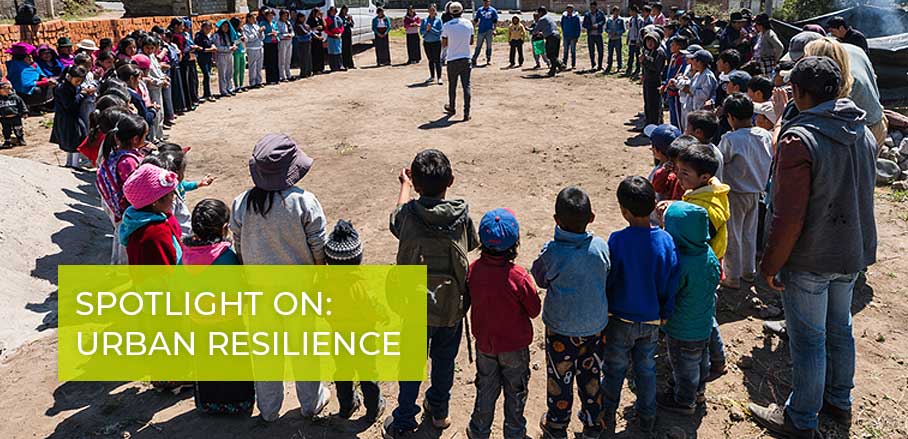Empowering Communities to Build Resilience: Quito, Ecuador
Quito, Ecuador is facing a variety of natural hazards, making it imperative to develop proper resilience strategies. David Jácome Polit, the city’s Chief Resilience Officer, explains why any such strategy has to be based on a neighbourhood’s social structure.
The 2.6 million inhabitants of the Metropolitan District of Quito are exposed to a wide range of acute shocks, such as earthquakes, volcanic eruptions, or landslides, to name a few. The repercussions of such events are even more seriously felt by the large number of residents in places unsuited for settlements, who are especially vulnerable.
Yet, in the same place there may also be the strength to face challenges, to be found in the construction and strengthening of the social structures that are needed to create social support networks – which in turn are needed to prepare for and appropriately respond to disasters in a multi-threat city like Quito.
Citizen co-responsibility should be established by building citizen’s capacity to manage and endorse participatory development agendas contributing to a city’s resilience. This creates the ability for close cooperation between public authorities, citizens, and private stakeholders, aiming at leaving no one behind on a day-by-day basis as well as during and after extraordinary difficult times.
Understanding Risk: Hazards, Exposure, and Vulnerability
One important aspect when thinking about resilience is to have a common understanding of risk and its three components. A hazard refers to the possibility of any event that would negatively affect the lives, livelihoods, or the environment of a community. Exposure is the location and physical condition of settlements in hazard-prone areas. Vulnerability refers to the ability of exposed communities to recover from such an event in a way that people have the same quality of life as before the event, or even better.
While it is important to understand the hazards and level of exposure, it is crucial to recognise that vulnerability means much more than the likelihood of buildings to collapse or infrastructure to be damaged. Vulnerability is a concept that extends into the socioeconomic realm. Hence, dimensioning risk necessarily requires an understanding of where vulnerable people are located and how they and their livelihoods can be affected by disasters – only thus can efforts be focussed towards most needed locations.
Coping Capacity
Another important term when it comes to facing risks is that of coping capacity, defined by the UN Office for Disaster Risk Reduction (UNDRR) as “the ability of people, organizations and systems, using available skills and resources, to face and manage adverse conditions, emergencies or disasters”.
Evidence suggests that strengthening communities’ coping capacity should be an integral part of risk management plans that think beyond the disastrous event itself and are aimed at a fast recovery. For example, during and after the 2016 earthquake in Ecuador it was also the courage and strength of affected provinces’ residents, as well as the solidarity that other cities and citizens showed, that helped to face the challenges of having been struck by such a great tragedy.
Citizen Programmes for Resilience
Despite this evidence, citizen participatory programmes that promote neighbourhood self-organisation, governance capacity, and solidarity among citizens are often overlooked or seen as processes with limited value, since they demand too much time, energy, and human resources in addition to focussing efforts on areas not always congruent with local political agendas. Furthermore, governments sometimes worry that empowering people may result in yielding power and representativeness away from a government.
Instead of giving in to such fears, local governments should aim at promoting autonomous organisation of neighbourhoods that equips residents with the capacity to make decisions about their own development and to come up with processes to contribute to the city’s effort in risk management. This results in a committed and co-responsible community and a variety of additional positive outcomes:
Intense citizen discussions and deliberations extract the best possible solutions while the authorities’ perspective on these challenges and opportunities is enriched.
People recognise the potential of self-organisation, community planning, and focussing a neighbourhood’s efforts, creating awareness that the collective can shape solutions for urban challenges.
Awareness of natural or manmade threats and their impacts is raised among community members, co-responsibility is also extended to face these possible events.
Participation as Key
If the outcomes of such participatory programmes are articulated through risk management plans which are then implemented properly, then there is a lot of hope that this community will cope with catastrophic events.
In Quito, residents can design their own neighbourhood resilience strategies after having received respective trainings. These were provided by the Metropolitan Directorate of Resilience with support of the Metropolitan Directorate of Citizen Participation.
These agendas have proven to be effective in recognising urgent challenges in various fields such as security, mobility, environmental degradation, economic inclusion, or natural or manmade threats. For example, many workshops recognised that one issue to work on is effective communication between the community and the police, which can positively affect the way crimes are dealt with.
It is true that a city’s resilience is only really tested after a disaster has occurred. The same applies to assessing how well communities are prepared and organised. Yet, efforts need to be allocated for building capacities in communities beforehand.
Participatory programmes must be seen as the starting point in any planning process and in any development agenda. Stronger and more effective communication between local government sectors, civil society, and academia is key in the further development of such programmes. We need to make time for developing the necessary skills in our organisations, unless we are to remain more vulnerable, with less response capacity, and with less ingenuity in proposing solutions.
- Resilience After Covid19 – A System-Thinking Approach - 18. June 2020
- Empowering Communities to Build Resilience: Quito, Ecuador - 1. October 2019
